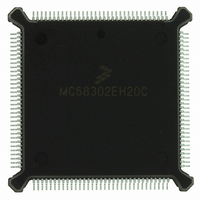MC68302EH20C Freescale Semiconductor, MC68302EH20C Datasheet - Page 187

MC68302EH20C
Manufacturer Part Number
MC68302EH20C
Description
IC MPU MULTI-PROTOCOL 132-PQFP
Manufacturer
Freescale Semiconductor
Datasheets
1.MC68302AG20C.pdf
(4 pages)
2.MC68302AG20C.pdf
(2 pages)
3.MC68302AG20C.pdf
(13 pages)
4.MC68302EH20C.pdf
(481 pages)
Specifications of MC68302EH20C
Processor Type
M683xx 32-Bit
Speed
20MHz
Voltage
5V
Mounting Type
Surface Mount
Package / Case
132-MQFP, 132-PQFP
Family Name
M68000
Device Core
ColdFire
Device Core Size
32b
Frequency (max)
20MHz
Instruction Set Architecture
RISC
Supply Voltage 1 (typ)
5V
Operating Temp Range
0C to 70C
Operating Temperature Classification
Commercial
Mounting
Surface Mount
Pin Count
132
Package Type
PQFP
Lead Free Status / RoHS Status
Lead free / RoHS Compliant
Features
-
Lead Free Status / Rohs Status
Compliant
Available stocks
Company
Part Number
Manufacturer
Quantity
Price
Company:
Part Number:
MC68302EH20C
Manufacturer:
Freescale Semiconductor
Quantity:
10 000
Part Number:
MC68302EH20C
Manufacturer:
FREESCALE
Quantity:
20 000
Company:
Part Number:
MC68302EH20CB1
Manufacturer:
Freescale Semiconductor
Quantity:
10 000
Company:
Part Number:
MC68302EH20CR2
Manufacturer:
Freescale Semiconductor
Quantity:
10 000
- MC68302AG20C PDF datasheet
- MC68302AG20C PDF datasheet #2
- MC68302AG20C PDF datasheet #3
- MC68302EH20C PDF datasheet #4
- Current page: 187 of 481
- Download datasheet (2Mb)
The 8- or 16-bit control field provides a flow control number and defines the frame type (con-
trol or data). The exact use and structure of this field depends upon the protocol using the
frame.
Data is transmitted in the data field, which can vary in length depending upon the protocol
using the frame. Layer 3 frames are carried in the data field.
Error control is implemented by appending a cyclic redundancy check (CRC) to the frame,
which is 16-bits long in most protocols, but may be 32-bits long in some.
When the MODE1–MODE0 bits of an SCC mode register (SCM) select the HDLC mode,
then that SCC functions as an HDLC controller. The HDLC controller handles the basic func-
tions of the HDLC/SDLC protocol on either the D channel, a B channel, or from a multiplexed
serial interface (IDL, GCI (IOM-2), or PCM highway). When the HDLC controller is used to
support the B or D channel of the ISDN, the SCC outputs are internally connected to the
physical layer serial interface.
When an SCC in HDLC mode is used with a nonmultiplexed modem interface, then the SCC
outputs are connected directly to the external pins. In this case, the serial interface uses sev-
en dedicated pins: transmit data (TXD), receive data (RXD), receive clock (RCLK), transmit
clock (TCLK), carrier detect (CD), clear to send (CTS), and request to send (RTS). Other
modem signals may be supported through the parallel I/O pins.
The HDLC controller consists of separate transmit and receive sections whose operations
are asynchronous with the M68000 core and may be either synchronous or asynchronous
with respect to the other SCCs. Up to eight frames may be transmitted or received without
M68000 core intervention. When the HDLC controller is connected to one of the multiplexed
physical interface options (IDL, GCI, or PCM highway), the receive and transmit clocks are
identical and are supplied externally by the physical layer. In non-ISDN applications, each
clock can be supplied either from the baud rate generator or externally. The baud rate gen-
erator is discussed more fully in 4.5.2 SCC Configuration Register (SCON).
The HDLC controller key features are as follows:
MOTOROLA
• Flexible Data Buffers with Multiple Buffers per Frame Allowed
• Separate Interrupts for Frames and Buffers (Receive and Transmit)
• Four Address Comparison Registers with Mask
• Maintenance of Five 16-Bit Error Counters
• Flag/Abort/Idle Generation/Detection
• Zero Insertion/Deletion
• NRZ/NRZI Data Encoding
• 16-Bit or 32-Bit CRC-CCITT Generation/Checking
SDLC is fully supported, but the SDLC loop mode (ring configu-
ration) is not supported.
MC68302 USER’S MANUAL
NOTE
Communications Processor (CP)
4-67
Related parts for MC68302EH20C
Image
Part Number
Description
Manufacturer
Datasheet
Request
R
Part Number:
Description:
Manufacturer:
Freescale Semiconductor, Inc
Datasheet:

Part Number:
Description:
MC68302 Configuring the Chip Selects on the MC68302
Manufacturer:
Motorola / Freescale Semiconductor

Part Number:
Description:
MC68302 Design Concept - Expanding Interrupts on the MC68302
Manufacturer:
Motorola / Freescale Semiconductor

Part Number:
Description:
MC68302 MC68302 Adapting a WAN Controller to a LAN Environment
Manufacturer:
Motorola / Freescale Semiconductor

Part Number:
Description:
MC68302 EKB Applications - Power Measurements on the MC68302
Manufacturer:
Motorola / Freescale Semiconductor

Part Number:
Description:
MC68302 Interfacing the MC68020 to a Slave MC68302
Manufacturer:
Motorola / Freescale Semiconductor

Part Number:
Description:
MC68302 MC68302 Software Performance
Manufacturer:
Motorola / Freescale Semiconductor

Part Number:
Description:
MC68302 Evaluating EDX on the ADS302
Manufacturer:
Motorola / Freescale Semiconductor

Part Number:
Description:
MC68302 Design Advisory #1 - MC68SC302 Passive ISDN Protocol Engine
Manufacturer:
Motorola / Freescale Semiconductor

Part Number:
Description:
MC68302, MC68360, and MPC860 Characteristics and Design Notes for Crystal Feedback Oscillators
Manufacturer:
Motorola / Freescale Semiconductor
Part Number:
Description:
Mc68302 Integrated Multi-protocol Processor
Manufacturer:
Freescale Semiconductor, Inc
Datasheet:
Part Number:
Description:
Manufacturer:
Freescale Semiconductor, Inc
Datasheet:
Part Number:
Description:
Manufacturer:
Freescale Semiconductor, Inc
Datasheet:
Part Number:
Description:
Manufacturer:
Freescale Semiconductor, Inc
Datasheet:
Part Number:
Description:
Manufacturer:
Freescale Semiconductor, Inc
Datasheet:











